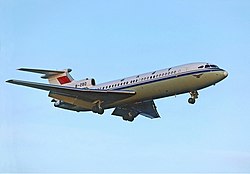CAAC Flight 301,[1]aHawker Siddeley Tridentoperated byCAACGuangzhou Regional Administration(nowChina Southern Airlines) fromGuangzhou BaiyuntoHong Kong Kai Tak,ran off the runway inHong Kongon 31 August 1988 after clipping approach lights. This was the first accident of China Southern Airlines since the split of CAAC Airlines from 1 July 1988. Six crew members and one passenger perished in the accident. The crash shut down Kai Tak Airport for more than six hours after the accident.[2]
 B-280, a CAAC Trident sister ship of the accident aircraft. | |
| Accident | |
|---|---|
| Date | 31 August 1988 |
| Summary | A combination of pilot error and bad weather |
| Site | Kowloon BaynearKai Tak Airport,Hong Kong |
| Aircraft | |
| Aircraft type | Hawker Siddeley Trident 2E |
| Operator | CAACGuangzhou Regional Administration(nowChina Southern Airlines) |
| Registration | B-2218 |
| Flight origin | Guangzhou Baiyun International Airport (former) |
| Destination | Hong Kong Kai Tak Airport |
| Occupants | 89 |
| Passengers | 78 |
| Crew | 11 |
| Fatalities | 7 |
| Injuries | 15 |
| Survivors | 82 |

Aircraft
editThe aircraft involved was a British-built Hawker Siddeley Trident 2E, powered by threeRolls-Royce Spey512-5W, The first flight was in 1973. Total airframe hours were 14,332, C/n /msn 2159. Registration was B-2218.[1]
Accident sequence
editWhile on final approach to Kai Tak Airport, in rain with 450 metres (1,480 ft) visibility, the right wing of theHawker Siddeley Tridentoperating the flight clipped approach lights ofRunway31 and the main landing gear tyres hit the runwaypromontory,causing the right main landing gear to be ripped from the wing. The aircraft then became airborne and impacted the runway 600 metres further on. The aircraft then veered off the runway to the right and diagonally crossed the grassed runway strip surrounding it. The nose and left main landing gear then collapsed and the aircraft slid over the paralleltaxiwayand intoKowloon Bay.[1] The cockpit was cut off and the rest of the aircraft was intact. Attempts were made by divers to get to the cockpit where the flight crew were stationed but were unsuccessful, the cockpit crew were injured by the impact but autopsies showed that the cause of death was from drowning.[3]
Passengers
editOf the 89 occupants of the aircraft, seven died and an additional 15 received injuries. Of the dead, six were crew members and one was aHong Kongpassenger who succumbed to his injuries in a hospital. The dead crew members were in the front of the aircraft. Three crew members, all Chinese, received injuries and survived. Of the 12 American passengers, two received injuries. Seven Hong Kong passengers, two Taiwanese passengers, and one Frenchman received injuries. One injured passenger was a Chinese-American.[2]
Investigation
editThe report noted "From the limited evidence available it was not possible to positively determine the cause of the accident. The report concludes that the final approach became unstable, and thatwindshearmay have been a contributory factor. The final deviation below the normal approach path was probably due to a sudden reduction and distortion of the visual reference caused by heavy rain. "The report further noted that"... The accident was survivable. The flight crew were not wearing shoulder harness. A sixth crew in the flight compartment was sitting on a small metal stool that was not fastened in any way.... There were no safety leaflet for passengers.... One cabin crew did not fasten her seat belt while landing.... No lifejackets were carried for passengers despite approaches and departures were over water'[4]
See also
editDelta Air Lines Flight 1141Another crash that occurred later on the same day, also slid off the runway. Technically, it was still 30 August in Texas when the CAAC crash occurred, but it was the 31st in Hong Kong.
References
edit- ^abc"ASN Aircraft Accident Hawker Siddeley Trident B-2218".aviation-safety.net.Retrieved15 July2012.
- ^ab"Chinese plane crashes in Hong Kong harbor."Associated PressatThe Day(New London, Connecticut). Thursday 1 September 1988. p. D8. Retrieved fromGoogle Newson April 9, 2013.
- ^"Report on the accident to Hawker Siddeley Trident 2E B-2218 at Hong Kong International Airport on 31 August 1988"(PDF).Hong Kong Civil Aviation Department Accidents Investigation Division. Archived fromthe original(PDF)on 2012-11-08.Retrieved2012-07-28.
- ^"CAAC Flight 301 Accident Report"(PDF).Archived fromthe original(PDF)on 2012-11-08.Retrieved2012-07-17.